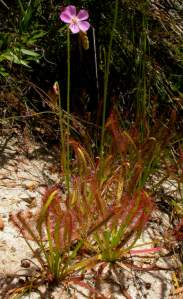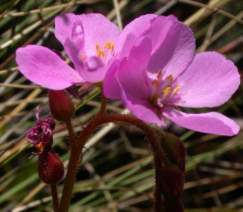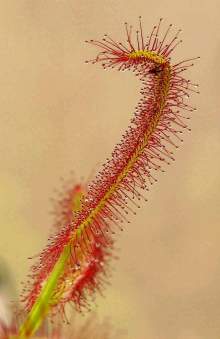Drosera capensis
Drosera capensis L.
Family: Droseraceae
Common names: Cape sundew (Eng.); sondouw (Afr.)
Introduction
Glistening dewdrops adorn the strap-like leaves of the sundew, enticing insects to their deaths.

Description
Description
Drosera capensis is a free-flowering, robust, carnivorous, evergreen perennial, of varying height, but usually around 150 mm. The short, woody stems are rhizomatous below with well-developed roots.

The leaves radiate from the stem and are made up of a petiole and lamina, the petiole being almost the same length as the lamina. The lamina is flattened and bears knob-shaped tentacles, which are stalked, mucilaginous glands covering the leaf surface. Dense fringes of tentacles occur on the margins while fewer and shorter tentacles occur in the centre. The lower lamina surface is smooth and glabrous.

The 15-30, simple, pink-mauve flowers are borne on a single stem and mature in ascending order. Tiny black seeds are formed in the capsules. Flowering time: December to January.

Conservation Status
Status
Not threatened.
Distribution and habitat
Distribution description
Drosera capensis occurs naturally in the southwestern Cape and can be found in marshes, along streams, permanent seeps or damp areas of fynbos.
Derivation of name and historical aspects
History
The family Droseraceae was classified by Linnaeus in 1753, and consists of ± 126 species of which 18 occur in South Africa . Drosera gets its name from the Greek word, drosos , meaning dew. Some of the other commonly known species within this family are D. cistiflora, with one of the largest flowers, D. glabripes with its trailing woody stems and D. regia the king drosera.
Ecology
Ecology
Flowers are open very briefly for a few hours with good sunlight. The flowers can be pollinated by insects, but are usually self-pollinated. When the seeds are ripe, their capsules open to release the fine, light-weight seeds which fall out and are dispersed near the parent plants.
Probably the most interesting characteristic of this plant is its ability to digest the nutrients, especially the nitrogen it requires from insects caught in its stalked tentacles. The tentacles are sensitive and mobile. The stalks end in a bulbous head in which the glandular cells occur. These glands secret a glistening, sticky, clear fluid used to trap and retain prey. There is speculation that the fluid is slightly sweetly scented to attract insects. The fluid contains a weak acid and enzymes that digest the soft parts of its prey. The sensitive tentacles are able to detect caught prey and produce more dew to entrap their victim. Neighbouring tentacles then mobilize and slowly lean over to engulf the hapless victim.

The leaf itself may also fold over to enclose or suffocate larger prey and allow for better absorption.

As sensitive as these tentacles are, they are able to distinguish between a meal and other stimuli, for example, the leaf and tentacles do not respond to water droplets.
Uses
Use
The Cape sundew is fast growing and single plants can live for many years with young suckers forming at the base. It is a free-flowering and fascinating house plant. It can also be grown outdoors in South Africa in a bog garden or as a semi-submerged pond plant.
Drosera has also been recorded for use against various ailments. Extracts of the leaves were used externally for warts, corns and sunburn. Disorders such as tuberculosis, asthma, coughs, eye and ear infection, liver pain, morning sickness, stomach conditions, syphilis, toothache and intestinal problems were treated internally with teas or extracts made from the leaves. The tea was also used as a tranquilizer and some believe that it has aphrodisiac properties. Anti-spasmodic agents have been found by scientists in some Drosera species.
Growing Drosera capensis
Grow
Drosera capensis is one of the hardiest carnivorous plants to grow. It tolerates a variety of soils which low in nutrients. General growth media, 1 part sand or silica grit: 1 peat or sphagnum moss in 10-15 cm pots are ideal. Place the potted plants in a 1-3 cm saucer filled with fresh water to remain moist at all times. Place in a northern or eastern direction for best sunlight if growing indoors. Grow in full sun to semi-shade outdoors.
The Cape sundew is easily propagated by seed or vegetative means. Prepare a 9 cm pot with growth media, water well. Sow fresh seeds on the surface in moist growth media. Do not cover with soil.
Partially cover healthy living root or leaf cuttings with growth media. Place in a well-lit area but not in direct sunlight. Cover pots with plastic to retain humidity. Once young leaves develop, pierce the plastic to allow for acclimatization and hardening off.
Acidic or epiphytic foliar feed may be used at ¼ recommended strength once a month.
Ironically, the carnivorous plants are attacked by insect pests. Aphids, mealy bug and thrips cause deformity in new growth. Treat with a diluted pesticide or remove pests by hand. Never use a soap-based insecticide. Drying out can cause drooping and the decrease in mucilage production. Watering and keeping the plant moist will revive them. Dew production may stop after transplanting or if the leaf comes into contact with inquisitive hands. New foliage will, however, grow and continue to produce dew. Mature plants die off from time to time, but usually young shoots develop off their rhizomatous stems, so wait a few weeks before you throw them out!
References
- D'Amato, P. 1998. The Savage Garden: Cultivating Carnivorous Plants. Ten Speed Press, California.
- Gibson, R. 1993. Cape sundew: Drosera capensis : know it and grow it. Veld & Flora 79: 54, 55.
- Manneveldt, G.W. 1998. Sundews. Veld & Flora 84: 10, 11.
- Voigt, W. 2003. Plants with appetite. Veld & Flora 89: 18-20.
Credits
Author : Monique McQuillan
Photographs : Adam Harrower
Kirstenbosch National Botanical Garden
February 2008
Plant Attributes:
Plant Type: Carnivorous
SA Distribution: Eastern Cape, Western Cape
Soil type: Sandy
Flowering season: Late Summer, Autumn
PH: Acid
Flower colour: Pink, Mauve/Lilac
Aspect: Full Sun, Morning Sun (Semi Shade), Afternoon Sun (Semi Shade)
Gardening skill: Challenging
Special Features:
Horticultural zones







Rate this article
Article well written and informative
Rate this plant
Is this an interesting plant?
Login to add your Comment
Back to topNot registered yet? Click here to register.